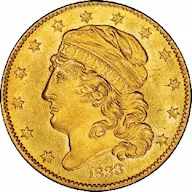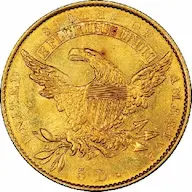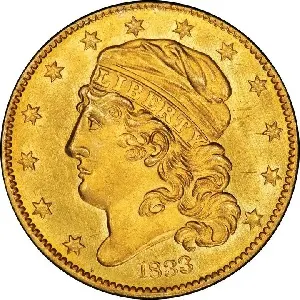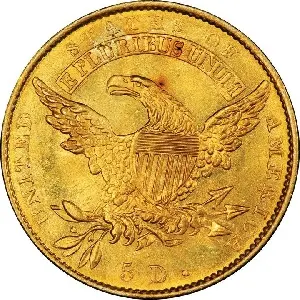1833 Capped Head $5 Half Eagle, Small Date
The story of the 1833 Capped Head Small Date $5 half eagle closely parallels that of 1833 Large Date half eagle.
1833 was the penultimate year of production for Capped Head $5 half eagle. Boosted by gold flowing in from mines in Georgia and the Carolinas, a generous mintage of 193,630 gold $5 pieces rolled off the Philadelphia coin presses that year.(1)
During those times, the half eagle was the gold denomination preferred most by the public. The $2.50 quarter eagle was available, bit few bullion depositors requested it. Production of the $10 eagle was suspended in 1804, so it was not an option.
There are two major varieties of the 1833 half eagle, distinguished by the width and logotype of the date. They are listed in most guides as the Large Date and Small Date, though some collectors refer to them as the Wide Date and Close Date, respectively.
These varieties were likely first detected by J. Colvin Randall (1832-1901), a Philadelphia numismatist who is credited with advancing the study of die varieties for early United States gold and silver coins.(2)
The 1833 Large Date half eagles were all struck with a single pair of dies (Bass-Dannreuther-1). For the Small Date, two die marriages were employed: BD-2 and BD-3, differing mainly by the location of the period after the “5 D” denomination on the reverse. All variants are remarkable acquisitions, but the BD-3 is incredibly rare.(3)
If it had not been for world events in the early 19th century driving the price of gold higher, there might be enough Capped Head half eagles to satisfy collectors of today. Instead, virtually all of them vanished in melting pots.
In the U.S., bullion profiteers could obtain one dollar in gold coin for 15 dollars in silver, then ship it to Europe where the gold exchanged at a 16:1 ratio of silver to gold. In other words, U.S. gold coins were worth more in other countries than their stamped face value. This led to widespread hoarding and melting.(4)
On June 28, 1834, Congress finally addressed this situation by lowering the gold content of U.S. coinage. However, extensive melting continued. That’s because the heavier “old tenor” coins could be returned to the Mint at a rate of $5.32 for every $5.00 turned in. The Mint needed gold to make lighter “new tenor” gold coins needed in large quantities for American commerce.(5)
These events explain why just 0.1% of the original population for Capped Head half eagles survive to this day.(6) The series hosts some of the most famous rarities in United States numismatics. Most collectors can only dream of owning just a single example!
| Estimated survivors in all grades: 35 ?
The survivor estimate from researcher John Dannreuther. |
| PCGS Rarity Scale: 8.8 ?
The 'PCGS CoinFacts Rarity Scale' assesses the relative rarity of all U.S. coins, based on estimated surviving examples. The scale runs from 1.0 to 10.0. The higher the number, the rarer the coin.
Learn more at PCGS. |
| Search for the 1833 Capped Head $5 Half Eagle, Small Date on eBay** |
Preview of eBay selection (extremely rare coin, seldom found for sale):
 |
 |
| Trendline Avg = 20.29 | BETTER |
 |
 |
| Trendline Avg = 20.29 | BETTER |
Historic Value Trend Charts:
| Last updated 8-11-25 | Return to Key Date Coin List | |
| Compare to Common Date Coin of Same Type | ||
|
|
||
| Download Charts to Your Computer | ||
Sources
1. Stack's Bowers Galleries. 1833 Capped Head Half Eagle. BD-2. Small Date. Mar 2015 Auction.
2. Stack's Bowers Galleries. 1833 Capped Head Half Eagle. BD-2. Small Date. May 2016 Auction.
3. Heritage Auctions. 1833 $5 Small Date, BD-2. Jan 2017 Auction.
4. NGC. Capped Bust $5 (1807-1834).
5. Stack's Bowers Galleries. 1833 Capped Head Half Eagle. BD-2. Small Date. Mar 2015 Auction.
6. PCGS. Capped Bust $5.
**Many very fine coin dealers sell on eBay. At any point in time, there may be over one million search results for United States coins. This includes quite a few of the recommendations on our Key Date Coin List.
If you’re thinking about purchasing a rare coin, eBay is certainly worth a look. For your convenience, the links from this site to eBay are coded to bring up only coins certified by PCGS and NGC.
As is always, always the case, never buy a valuable coin from a seller whose trustworthiness cannot be verified. Learn more about this at our chapter Best Places to Buy Coins, which also has a section on doing business on eBay.
In the interest of full disclosure, Rare Coins 101 receives a small commission anytime someone connects to eBay from this site and purchases something.
Coin images by Stack's Bowers Galleries.


